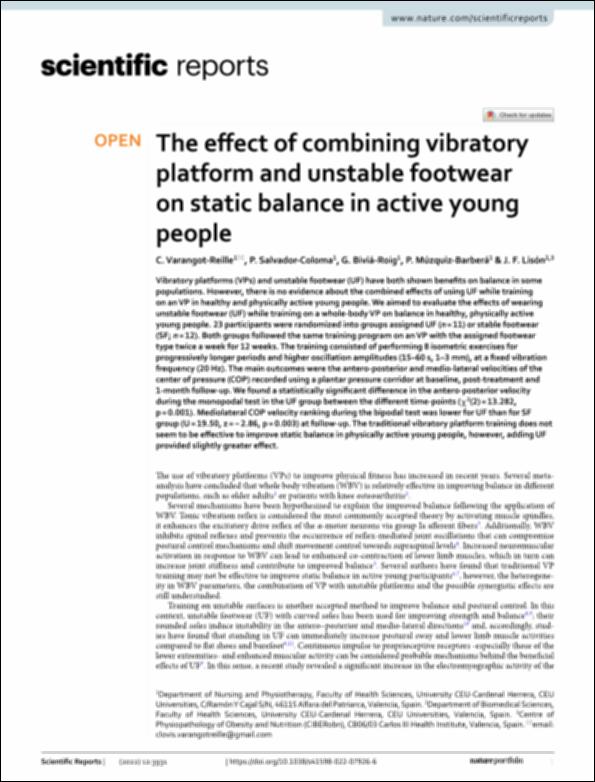Por favor, use este identificador para citar o enlazar este ítem:
http://hdl.handle.net/10637/14224The effect of combining vibratory platform and unstable footwear on static balance in active young people
| Título : | The effect of combining vibratory platform and unstable footwear on static balance in active young people |
| Autor : | Varangot Reille, C. Salvador Coloma, Pablo Biviá Roig, Gemma Múzquiz Barberá, Pedro Lisón Párraga, Juan Francisco |
| Materias: | Musculoskeletal system - Physiology.; Jóvenes - Ejercicio físico.; Sistema musculoesquelético - Fisiología.; Ejercicio físico - Aspectos fisiológicos.; Calzado - Propiedades mecánicas.; Youth - Exercise.; Exercise - Physiological aspects.; Footwear - Mechanical properties. |
| Editorial : | Springer Nature |
| Citación : | Varangot-Reille, C., Salvador-Coloma, P., Biviá-Roig, G., Múzquiz-Barberá, P. & Lisón, J.F. (2022). The effect of combining vibratory platform and unstable footwear on static balance in active young people. Scientific Reports, vol. 12, art. 3931 (10 mar.). DOI: https://doi.org/10.1038/s41598-022-07926-6 |
| Resumen : | Vibratory platforms (VPs) and unstable footwear (UF) have both shown benefits on balance in some populations. However, there is no evidence about the combined effects of using UF while training on an VP in healthy and physically active young people. We aimed to evaluate the effects of wearing unstable footwear (UF) while training on a whole-body VP on balance in healthy, physically active young people. 23 participants were randomized into groups assigned UF (n = 11) or stable footwear (SF; n = 12). Both groups followed the same training program on an VP with the assigned footwear type twice a week for 12 weeks. The training consisted of performing 8 isometric exercises for progressively longer periods and higher oscillation amplitudes (15–60 s, 1–3 mm), at a fixed vibration frequency (20 Hz). The main outcomes were the antero-posterior and medio-lateral velocities of the center of pressure (COP) recorded using a plantar pressure corridor at baseline, post-treatment and 1-month follow-up. We found a statistically significant difference in the antero-posterior velocity during the monopodal test in the UF group between the different time-points (χ2(2) = 13.282, p = 0.001). Mediolateral COP velocity ranking during the bipodal test was lower for UF than for SF group (U = 19.50, z = − 2.86, p = 0.003) at follow-up. The traditional vibratory platform training does not seem to be effective to improve static balance in physically active young people, however, adding UF provided slightly greater effect. |
| Descripción : | Este artículo se encuentra disponible en la siguiente URL: https://www.nature.com/articles/s41598-022-07926-6#Abs1 |
| URI : | http://hdl.handle.net/10637/14224 |
| Derechos: | http://creativecommons.org/licenses/by/4.0/deed.es |
| ISSN : | 2045-2322 (Electrónico) |
| Idioma: | es |
| Fecha de publicación : | 10-mar-2022 |
| Centro : | Universidad Cardenal Herrera-CEU |
| Aparece en las colecciones: | Dpto. Enfermería y Fisioterapia |
Los ítems de DSpace están protegidos por copyright, con todos los derechos reservados, a menos que se indique lo contrario.


